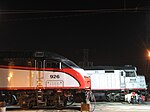Portal:Trains/Selected article/Week 51, 2017
The Caltrain Modernization Program (CalMod) is a $1.9 billion project that will add a positive train control (PTC) system and electrify the main line of the U.S. commuter railroad Caltrain, which serves cities in the San Francisco Peninsula and Silicon Valley, as well as transition from its current diesel-electric locomotive powered trains to electric multiple units (EMU). According to Caltrain, electrification of the tracks will allow it to improve service times via faster acceleration and shorter headways, reduce air pollution and noise, and facilitate a future railway tunnel (the Downtown Rail Extension) into downtown San Francisco's Transbay Transit Center (as diesel trains cannot serve underground stations). Proposals for electrifying the line began as early as 1992, when the California Department of Transportation conducted an early feasibility study. When completed, CalMod will electrify 51 miles (82 km) of tracks between 4th and King station and Tamien Station and install a PTC management system along the tracks. PTC is designed to fulfill federal safety mandates for passenger rail and is part of the Federal Railroad Administration (FRA) waiver to use EMUs on tracks shared with freight traffic. Funding for the project comes from various federal, state, and local sources, including from the California High-Speed Rail Authority. Caltrain plans to complete the project by 2021, after which it plans to use double-decker EMU Stadler Rail trainsets on the electrified route. Some of the diesel locomotives will be retained for service south of Tamien.
Recently selected: Coney Island–Stillwell Avenue (New York City Subway) - Columbia City station - City of Denver

